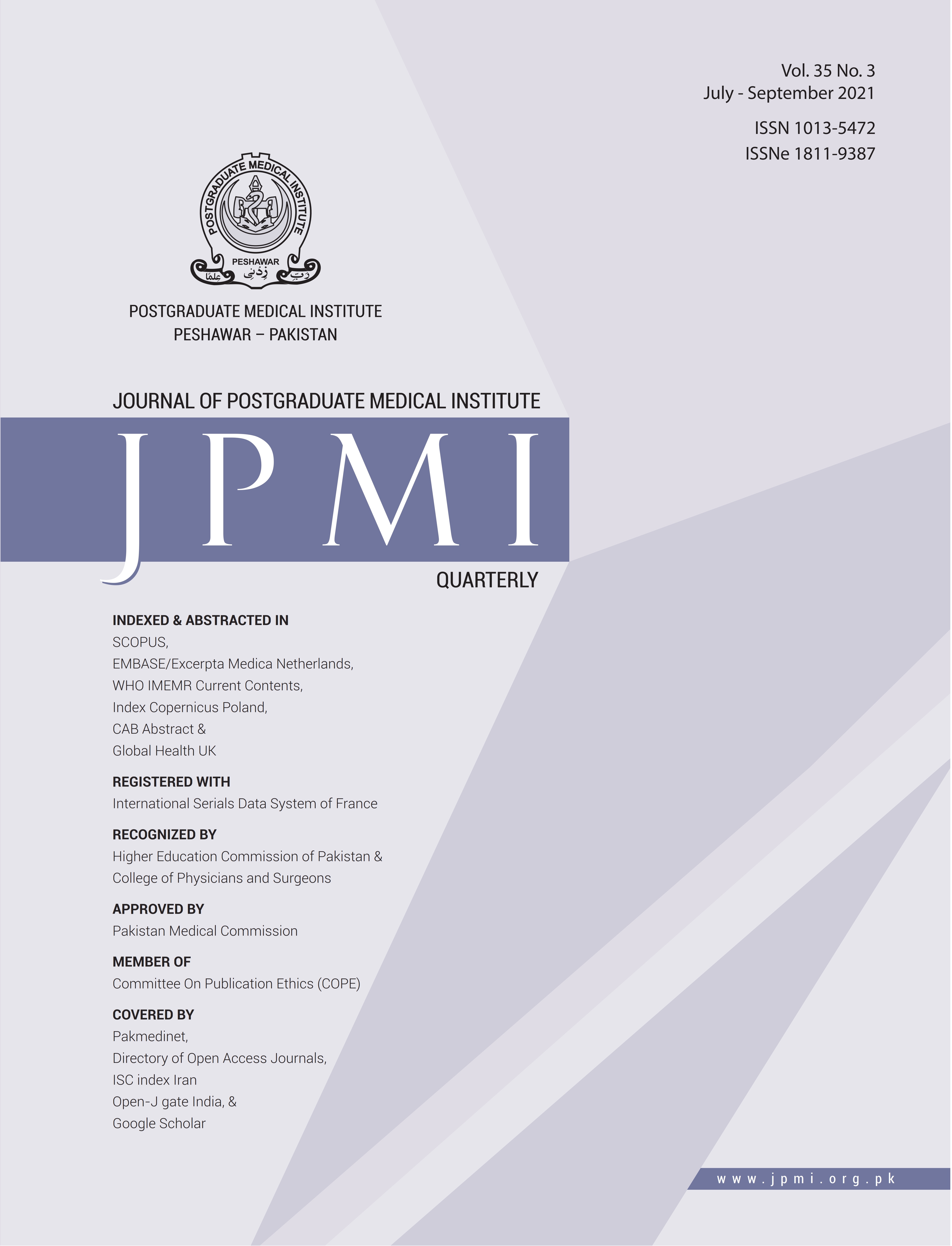ESTIMATING SENSITIVITY AND SPECIFICITY OF COVID 19 ANTIBODIES ASSAY POST RT-PCR TESTING
Main Article Content
Abstract
Objective: To determine sensitivity and specificity of Roche SARs-cov-2 antibodies assay using real time poly-marase chain reaction (RT-PCR) Covid-19 as standard in Pakistani population.
Methodology: It was a cross-sectional study conducted in Rehman Medical Institute Peshawar from 1st January 2021 till 15th February 2021. This study include 192 suspected Covid-19 patients. Serum samples set consisted of 122 symptomatic RT-PCR positive patients and 70 negative RT-PCR were used for qualitative detection of Antibodies (CoVID-19 IgG, IgM). Overall and period wise (Post RT-PCR) diagnostic accuracy was determined by comparing results of antibodies assay to Rt-PCR. Chi square test was applied to assess the correlation between post-PCR duration and Anti-SARS-Cov-2. A p-value of <0.05 was considered significant.
Results: On post-PCR duration and Anti-SARS-Cov-2 analysis, it was evident that the sensitivity of detection increased steadily with increase in duration after viral detection reaching a value of 94.5% after 20 days. Overall sensitivity was 86.9% with PPV of 97.3%. There was a significant level (X2= 6.846, p =.033) of correlation between detection probability of Antibodies and post-PCR duration at 95% Cl. Anti-SARS-Cov-2 showed a specificity of 95.7% and a NPV of 81.7%.
Conclusion: Our study demonstrated that in middle and later stages of disease antibodies to SARS-CoV-2 can be detected. This testing strategy can be utilized complementary to molecular-based testing of CoVID-19 diagnosis. Also, this can help in determining the seroprevalence of CoVID-19 in the community.
Article Details
Work published in JPMI is licensed under a
Creative Commons Attribution-NonCommercial 2.0 Generic License.
Authors are permitted and encouraged to post their work online (e.g., in institutional repositories or on their website) prior to and during the submission process, as it can lead to productive exchanges, as well as earlier and greater citation of published work.
References
Mahase E. Covid-19: WHO declares pandemic because of “alarming levels” of spread, severity, and inaction. BMJ. 2020; 368.
World Health Organization (WHO). WHO Coronavirus Disease (COVID-19) Dash¬board 2021. [Cited 2021 May 12]. Avi¬alable from: URL: https://covid19.who. int/
Govt of Pakistan. Pakistan cases details [online] 2021. [cited 2021 Nov 21]. Avi¬alable from: URL: https:// covid.gov.pk/ stats/pakistan.
Chan JFW, Yuan S, Kok KH, To KKW, Chu H, Yang J, et al. A familial clus¬ter of pneumonia associated with the 2019 novel coronavirus indicating per¬son-to-person transmission: a study of a family cluster. Lancet. 2020; 395(10223):514-23.
Bajema KL, Oster AM, McGovern OL, Lindstrom S, Stenger MR, Anderson TC, et al. Persons evaluated for 2019 novel coronavirus—United States, January 2020. Morb Mortal Wkly Rep. 2020; 69(6):166.
Huang C, Wang Y, Li X, Ren L, Zhao J, Hu Y, et al. Clinical features of patients infected with 2019 novel coronavi¬rus in Wuhan, China. Lancet. 2020; 395(10223):497-506.
Chen N, Zhou M, Dong X, Qu J, Gong F, Han Y, et al. Epidemiological and clini¬cal characteristics of 99 cases of 2019 novel coronavirus pneumonia in Wu¬han, China: a descriptive study. Lancet. 2020; 395(10223):507-13.
Wang D, Hu B, Hu C, Zhu F, Liu X, Zhang J, et al. Clinical characteristics of 138 hospitalized patients with 2019 novel coronavirus–infected pneumo¬nia in Wuhan, China. Jama. 2020; 323(11):1061-9.
Liu K, Fang Y-Y, Deng Y, Liu W, Wang M-F, Ma J-P, et al. Clinical characteris¬tics of novel coronavirus cases in ter¬tiary hospitals in Hubei Province. Chin Med J. 2020; 133(9):1025-31.
Yang X, Yu Y, Xu J, Shu H, Liu H, Wu Y, et al. Clinical course and outcomes of critically ill patients with SARS-CoV-2 pneumonia in Wuhan, China: a sin¬gle-centered, retrospective, observa¬tional study. Lancet Respir Med. 2020; 8(5):475-81.
ECDC. An overview of the rapid test situation for COVID-19 diagnosis in the EU/EEA. 2020.
Vashist SKJD. In vitro diagnostic assays for COVID-19: recent advances and emerging trends. Diagnostics. 2020; 10(4):202.
Li Z, Yi Y, Luo X, Xiong N, Liu Y, Li S, et al. Development and clinical application of a rapid IgM-IgG combined antibody test for SARS-CoV-2 infection diagnosis. J Med Virol. 2020; 92(9):1518-24.
Duggan J, Brooks T, Migchelsen S. Evaluation of Roche Elecsys Anti-SARS-CoV-2 serology assay for the detection of anti-SARS-CoV-2 antibodies. Public Health England. 2020.
Chauhan DS, Prasad R, Srivastava R, Jaggi M, Chauhan SC, Yallapu MM. Comprehensive review on current inter¬ventions, diagnostics, and nanotechnol¬ogy perspectives against SARS-CoV-2. Bioconjugate Chem. 2020; 31(9):2021- 45.
Lau CS, Hoo SP, Yew SF, Ong SK, Lum LT, Heng PY, et al. Evaluation Of The Roche Elecsys Anti-Sars-Cov-2 Assay. Medrxiv. 2020.
Bryan A, Pepper G, Wener MH, Fink SL, Morishima C, Chaudhary A, et al. Per¬formance characteristics of the Abbott Architect SARS-CoV-2 IgG assay and seroprevalence in Boise, Idaho. J Clin Microbiol. 2020; 58(8).
Riester E, Krieter B, Findeisen P, Laimighofer M, Schoenfeld K, Laengin T, et al. Performance of an automat¬ed anti-SARS-CoV-2 immunoassay in prepandemic cohorts. Medrxiv. 2020.
Zhao J, Yuan Q, Wang H, Liu W, Liao X, Su Y, et al. Antibody responses to SARS-CoV-2 in patients with novel coronavi¬rus disease 2019. Clin Infect Dis. 2020; 71(16):2027-34.
Herroelen PH, Martens GA, De Smet D, Swaerts K, Decavele AS. Humoral Im¬mune Response to SARS-CoV-2: Com¬parative Clinical Performance of Seven Commercial Serology Tests. Am J Clin Pathol. 2020; 154(5):610-9.
Bajema KL, Wiegand RE, Cuffe K, Pa¬tel SV, Iachan R, Lim T, et al. Estimated SARS-CoV-2 Seroprevalence in the US as of September 2020. JAMA Internal Med 2021; 181(4):450-60.


